

|
| articles | forbidden stories I-State Lines resources my hidden history reviews | home | ||

Writing/Film Don't Write for Readers, Just Write Grants Ernest Lehman, Screenwriter Central Casting, Dept. of Acceptable EVil Tinseltown Tags Titles from Bard When Empire Was Easy: Around the World in 80 Days Trois Colours: White Spirited Away: Decay and Renewal Suzhou River Blue: Love and Loss The Nelson Touch Running On Empty American Identity Hapas: The New America Can You Tell What I am? Part I Can You Tell What I am? Part II Only in America Self-Reliance Unfolding Crises: Asia China: An Interim Report Shanghai Postcard 2004 Japan's Runaway Debt Train Will Avian Flu Trigger a Global Depression? China and India: Five Flies in the Ointment China & the U.S.: Circle of Self-Interest China Trade Surplus: Gusher Profits for U.S. Air Pollution and China's Future China: What a difference 27 years makes China Irony: Steel, Marx & Capital Battle for the Soul of America Katrina, Vietnam, Iraq: National Purpose, National Sacrifice The End of Empire is Real Simple A Degree of Success Why the Democrats Keep Losing American Chickenhawks: Your Congress Is This a Nation at War? A Nation in Denial Hawaii National Guard: An Unfair Deployment The Great Karmic Unraveling This is not Vietnam American Dream or American Nightmare? Planetary Meltdown Watch The Immensity of Global Warming Financial Meltdown Watch What This Country Needs Is a... Good Recession Are We Entering the Next Age of Turmoil? Housing Bubble? What Bubble? Housing Bubble II Housing Bubble III: Pop! Meltdown in the E.U. Meltdown: U.S. - China Retirees: the New Elite? Boomers: Prepare to Fall on Your Swords The Real Federal Deficit The Word of the Decade: Gold The C.I.A., Oil and the Wisdom of Crowds Katrina's Long-Term Effects Catalyzing the Great Unraveling Welcome to 1935 Meltdown in the Making Is Risk Eliminated, or Merely Increased? Adios, O Bogus Prosperity The Flutter of a Butterfly's Wings? A One-Two Punch to a Glass Jaw Doubling Down on 5-Card No-See-Um Greenspan & The Conundrum Effect Why are we in this handbasket? Stock Market Tea Leaves The Scandals Yet to Come A Rickety Global House of Cards Hidden Costs of the Housing Bubble Are Japan and Germany Truly on the Mend? Unprecedented Risk 2 October Crash Redux Oil/Energy Crises Whither Oil? How much Is a Gallon of Gas Worth? The End of Cheap Oil Natural Gas, Naturally High Arab Oil Money and U.S. Treasuries: Quid Pro Quo? Outside the Box How to Make a Favicon Asian Emoticons In Memoriam: Winky Cosmos The Wheeled Vagabonds In a Humorous Vein If Only Writers Had Uniforms Opening the Kimono One-Word Titles Complacency Nostalgia Praxis Keys to Affordable Housing U.S. Conservation & China Steve Toma, Me & Skil 77s: 30 years of Labor Real Science in the Bolivian Forest Deforestation and Sustainable Forestry The Solar Economy (book) The Problem with Techno-Fixes Health, Wealth & Demographics Demographics and War The Healthiest Cold Cereal: Surprise! 900 Miles to the Gallon Are Our Cities Making Us Fat? One Serving of Deception Is Obesity an Inflammatory Response? Demographics & National Bankruptcy Landscapes Terroir: France & California L.A.: It's About Cheap Oil The Last Redwood Airport Walkabouts Nourishment The French Village Bakery Ideas Understanding Globalization: Braudel Can You Create Creativity? Do Average People Know More Than Their Leaders? On The Impermanence of Work Flattening the Knowledge Curve: The "Googling" Effect Human Bandwidth and Knowledge Iraqi Guangxi Splogs, Blogs and "News" History Bad Karma: Election Fraud 1960 Hiroshima: First Use All the Tea in China, All the Ginseng in America Essential Books The Misbehavior of Markets Boiling Point (Global Warming) Our Stolen Future: How We Are Threatening Our Fertility, Intelligence and Survival How We Know What Isn't So The Coming Generational Storm: What You Need to Know about America's Economic Future The Third Chimpanzee: The Evolution and Future of the Human Animal Beyond Oil: The View from Hubbert's Peak The Party's Over: Oil, War and the Fate of Industrial Societies The Dollar Crisis: Causes, Consequences, Cures Running On Empty: How The Democratic and Republican Parties Are Bankrupting Our Future and What Americans Can Do About It More book reviews Archives: weblog October 2005 weblog September 2005 weblog August 2005 weblog July 2005 weblog June 2005 weblog May 2005 What's New, 2/03 - 5/05 
|
Weblog and Wessays Welcome, readers, welcome. Please browse this month's weblogs and the wEssays listed in the sidebar. If you're in the mood for a short story, check out The Adventures of Daz and Alex: Stories of America. (They're all quick reads.) If nothing here strikes your fancy, skim through my recently published articles (generally in the San Francisco Chronicle) and my archives back to 1995. I would be honored if you link any essay to your website, print a copy for your own use or add my RSS or Atom feed. And of course I appreciate your recommendations of this weblog and your comments: csmith@oftwominds.com. November 30, 2005 Could One Rogue Trader Bring Down Global Financial Markets? Are world financial markets so precariously leveraged that a single rogue trader could bring down the entire global financial market? Before you scoff, consider the still-unfolding story of the rogue copper trader Liu Qibing who has saddled China with huge losses in copper futures. There is now talk that China will attempt to renege on the contracts to escape the $200 million loss. The story reveals how leveraged financial instruments such as futures contracts and options can disrupt "real" markets in "real" commodities. The same is true for currencies, bonds and stocks. While it's easy to dismiss one rogue trader and a meagre $200 million loss, what is not so easily dimissed is the enormous, highly leveraged, massively intertwined system of derivatives of which copper futures are only a small part. For more of the same, Martin Weiss of the Money Report says if you want to talk about derivatives, how about "$82 trillion held by US banks alone, according to the Office of the Comptroller of the Currency (OCC). That’s the 'notional' or face amount, which overstates the problem. But it’s still far too big — 33 times more than the entire budget of the U.S. government.As noted earlier here, these derivatives are increasingly popular "hedges" or "insurance" against risk. In other words, to protect yourself against a sudden drop in bonds, stocks, commodities or currencies you may be holding for appreciation or income, you purchase a derivative which increases in value if the asset drops. But what happens if every trader and "black box" relies on the same exit strategy? Trading companies rely quite heavily on sophisticated financial models of risk and return which are programmed into what is known as "black boxes." Few understand the complexities of the software models, so the output is as mysterious as if the contents were completely unknown--hence the moniker "black box." The dangers of "black box" trading was revealed in the Long-Term Capital Management crisis in 1998. The LTCM computer models kept indicating that an extreme in the market would turn around, so they kept betting on such a turnaround. As the bets went sour, they doubled down, and doubled down again; at the end, their derivatives bets almost brought down the banking system of the entire nation. What if the "black box" trading programs can't account for what the other "black boxes" are programmed to do in the event of a financial crisis similar to the LTCM contretemps in 1998? Since all the models are highly proprietary, how can anyone safely predict that the "black box" triggers would all work in some magic way to defuse the crisis rather than exacerbate it by "rational" dumping of assets and derivatives? We won't know, of course, until the crisis arrives, and it's too late to stop the unraveling of hundreds of trillions in derivative bets. To be blithely confident that no such crisis could ever erupt seems folly of the highest order. November 29, 2005 Another Day and Another (Billion) Dollar(s) in Debt--A vicious Cycle 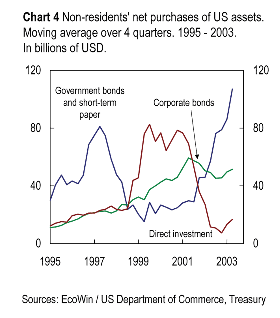 Our Thanksgiving dinner guests included one of the handful of wizards who trade billions of dollars
of currencies each and every day for one of the big global money-center banks. His comments on the
U.S. dollar are worth considering.
Our Thanksgiving dinner guests included one of the handful of wizards who trade billions of dollars
of currencies each and every day for one of the big global money-center banks. His comments on the
U.S. dollar are worth considering.
Though he works in New York, he is an Asian national who keeps close tabs on the financial pulses of Asian central banks. To paraphrase his commentary: the U.S. dollar and the global financial system is in a vicious cycle of debt and dollar purchases. The Asian banks, he explains, don't want to see the U.S. dollar collapse, for they know that if the U.S. economy goes down, so does the rest of the world. They are also not keen on seeing their already-vast portfolio of U.S. bonds depreciate along with the dollar. 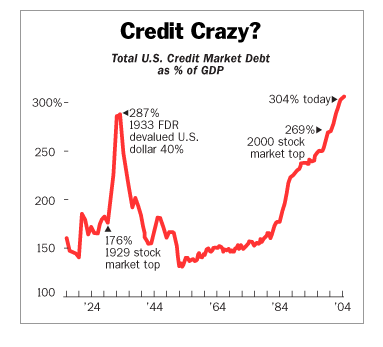 So they keep buying dollars and U.S. debt; what other choice do they have? Our friend explained that
everyone in the financial world knows the U.S. debt--$8 trillion and climbing at the Federal Government level,
plus untold trillions in local government, corporate and private mortgage debt--is unsustainable, and a
collapse of the dollar is inevitable; but the feeling is that the merry-go-round can spin a few more times
before it flies apart.
So they keep buying dollars and U.S. debt; what other choice do they have? Our friend explained that
everyone in the financial world knows the U.S. debt--$8 trillion and climbing at the Federal Government level,
plus untold trillions in local government, corporate and private mortgage debt--is unsustainable, and a
collapse of the dollar is inevitable; but the feeling is that the merry-go-round can spin a few more times
before it flies apart.
He went on to explain that banks sitting on huge wads of yen in Japan, where bonds earn basically zero percent return, look at 4.5% yields on bonds in the U.S. and reckon, why not make some quick money now by buying U.S. debt? The merry-go-round still has a few turns left in it, so let's buy dollars (raising the value of the dollar against the yen and other currencies) and buy U.S. Treasuries or corporate debt. As the accompanying chart shows, foreign entities have been huge buyers of U.S. debt since late 2001. As the second chart reveals, total U.S. debt is already at unprecedented levels. When debt reached a similar level in 1933, the dollar plummeted in value by 40%. Various pundits (including incoming Fed Chairman Ben Bernanke) suggest that the problem is not U.S. debt but a world awash in savings. If you look at the second chart, it's hard to give that rosy view much credence. The massive U.S. debt is real, as are the interest payments. Our friend also speculated what will happen when the merry-go-round stops spinning. Just as you'd imagine, he predicted a mad rush to be the first to unload the rapidly falling dollar and U.S. debt. But by then it will be too late, and the selling will trigger more selling in an overwhelming cascade. At that point, the vicious cycle will be running against the dollar, and all the imbalances which have been building up will be unleashed. If you also trade $10 billion to $100 billion a day in the currency markets, feel free to disagree. November 28, 2005 Zero Savings and Rising Retail Sales--Do ya reckon there's a connection? 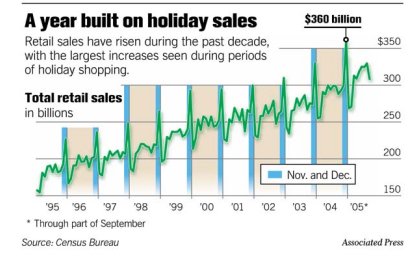 As the accompanying charts reveal, the nation's savings rate has plummeted from above 4% a decade ago to
less than zero today, while retail sales have skyrocketed over the same timespan.
As the accompanying charts reveal, the nation's savings rate has plummeted from above 4% a decade ago to
less than zero today, while retail sales have skyrocketed over the same timespan.
Do ya reckon there's a connection? At the risk of stating the obvious, we can conclude rather safely that these two key benchmarks of the health of the economy are indeed tightly correlated. And therein lies the danger. While savings create the capital needed to grow new enterprises and build new infrastructure, retail sales measure the growth of easy credit and an overload of advertising-induced desires. Which barometer best reflects the fiscal health of the nation? Savings or spending? 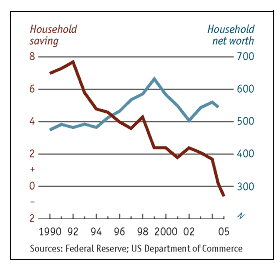 Wall Street hangs on every month's retail sales as if the
entire health of the American people's livelihoods and assets rest solely on ever-increasing retail sales.
Wall Street hangs on every month's retail sales as if the
entire health of the American people's livelihoods and assets rest solely on ever-increasing retail sales.
But what if retail sales are not the measure of health but of feverish profligacy, and it is the savings rate which accurately measures the fundamental health of the nation's finances? The received wisdom is that rising productivity and sales underpin prosperity; savings don't matter, as other nations' savers are apparently happy to lend us most of their savings to fund our deficits and carefree spending. But what if capital formation from spending less than you spend--savings--does matter? What if capital appreciation gained solely from asset bubbles (i.e. real estate appreciation) ends up being a sign of illness rather than robust health? What happens when retail sales plummet by 4% every month instead of rising by 4%? Those months must come, and perhaps sooner than expected, for no business cycle runs upward forever. Will it be all bad if Americans decide to start saving again rather than spending every dime they make plus some each and every month? Common sense suggests some prudent capital accumulation would be positive for the long-term health of the nation's economy, even if it spells doom for the retailers' stock prices. November 27, 2005 Sunday Self-Righteous Fascists Seek Ban on Cancer Vaccine Evil in its purest form darkens our land, hiding its true nature under the guise of false righteousness. Who would be so full of hatred and evil as to ban a vaccine against an insidious cancer? Surely anyone espousing such Evil is the moral equivalent of mass murderers such as Hitler, Stalin and Mao. Who could argue otherwise? So who are these fascists espousing what is essentially murder? The "Religious Right" and their toadies in Congress. As widely reported in the media, these incarnations of Evil claim the dark cloak of righteousness to obscure their own political agenda--a sentence of death for women who are infected with a sexually transmitted virus (human papilloma virus or HPV) which causes a fatal, incurable form of cervical cancer. These fascists are concerned only with their own interpretation of righteousness, which is focused entirely on the unsubstantiated conjecture that such a vaccine would turn innocent young women into harlots. What kind of lascivious mind could conjure up such a thought, without regard for the health of young women? What about the thousands of victims of rape and sexual abuse who may become infected with this deadly virus as a result of violent male evil? (Men are carriers of the virus but it does them no harm. Gosh, I wonder if the tables were turned and men were dying of HPV, would the self-righteous Republican Congressmen be so quick to block the vaccine? Do ya reckon?) Let us say these representatives of Evil Incarnate impose their political will on the nation and the vaccine is banned or limited, and as a result some of the tens of thousands of innocent rape victims do contract HPV from their attackers. To maintain a morally consistent jurisprudence, we must condemn these male Congressmen and Pseudo-Religious Right leaders who banned the vaccine for murder, for they carry the same guilt as the rapist himself. There can be no other moral conclusion. If these self-righteous men were indeed given the same sentences as their fellow murderers and rapists, then they would soon discover the horrors experienced by the rape victims they so callously condemned to death; for their flaccid white derrieres would make tempting fresh meat to the coarser and more violent inhabitants of our nation's state prisons. Let me take down my worn and stained Bible from my shelf, (inscribed "Given to Charles Smith in recognition of his faithfulness by the Silverlake Presbyterian Church, June 24, 1962") and seek out what the Good Book has to say about politicians who act, like Hitler himself, with the blessing of a self-proclaimed Christianity. They act as if there were an 11th and 12th Commandants which read, ""place thyself between the Believer and God, and maketh your own interpretations of his Will in thine own image," and "Thou shalt take it upon thyself to act as Judge and prosecutor of righteousness, setting thyself above God." Yet I find no such 11th or 12th Commandants in the Bible, instructing the self-righteous to impose their political interpretations as if they sat on the right hand of God. I find instead that these men are the epitome of sin and evil. Consider the source of evil--the heart of the sinner: 
"For from within, OUT OF THE HEART OF MAN, come evil thoughts, fornication, theft, murder, adultery, coveting, wickedness, deceit, licentiousness, envy, slander, pride, foolishness. All these evil things COME FROM WITHIN and defile a man." (Mark 7:18-23). (emphasis added)What are these self-proclaimed righteous but immoral, impure evil men, filled with anger and hatred for women, utterly selfish in their disregard for the health of innocent victims of rape, date rape and abuse, drunk with their own self-proclaimed glory, covetous of power, filled to the overflowing with pride and a dozen other sins? Who are they to judge what is righteous and good for the health of the nation's women? These self-glorying politicians are nothing but blasphemers and murderers; if you read the Bible, there is no other interpretation of their actions, deeds and words. If we understand the original Hebrew word correctly, then we find that Satan is more accurately translated as "adversary." These men are filled with the greatest of sins, hatred, pride, self-glorification, indeed, everything that is adversarial to Jesus' message of love, faith, forgiveness and charity. In this sense, they are well and truly Satan incarnate. November 25, 2005 Those Low Prices Aren't Cheap  If you look at the big picture, those "always low prices" you get at Wal-Mart or Target aren't actually
cheap--they're just subsidized, in various ways, by the bleary-eyed American taxpayer.
Subsidized, you say? How? Let me count the ways:
If you look at the big picture, those "always low prices" you get at Wal-Mart or Target aren't actually
cheap--they're just subsidized, in various ways, by the bleary-eyed American taxpayer.
Subsidized, you say? How? Let me count the ways:
But aren't low wages "necessary" to bring you, the consumer, the lowest prices? If this is so, then why can Costco pay living wages and benefits and still turn a profit? Could it be that mere greed drives Wal-Mart's pathetic wage and benefit structure rather than business necessity? There is another way--build products which are made to last and require the consumer to pay for their recycling costs in the purchase price. "Always low prices" aren't low; they're simply subsidized. November 24, 2005 Happy Thanksgiving  What could be more American than homemade apple pie (not just the crust, but the filling, too,
with peeled apples of various kinds)
shared with friends from around the world? We are blessed with friends of many heritages and from
many places; we will enjoy this pie with friends from Japan and Sweden as well as other states in the U.S.
What could be better than the world coming together for a homemade Thanksgiving?
What could be more American than homemade apple pie (not just the crust, but the filling, too,
with peeled apples of various kinds)
shared with friends from around the world? We are blessed with friends of many heritages and from
many places; we will enjoy this pie with friends from Japan and Sweden as well as other states in the U.S.
What could be better than the world coming together for a homemade Thanksgiving?
November 23, 2005 The False Gods of Consumerism  In recognition of the 'official' launch of the Christmas Shopping Season tomorrow, I offer this revised
version of the American flag, complete with Wal-Mart logo and the essential message of the mighty Consumer
gods who currently rule the land:
Always Low Prices, Always.
In recognition of the 'official' launch of the Christmas Shopping Season tomorrow, I offer this revised
version of the American flag, complete with Wal-Mart logo and the essential message of the mighty Consumer
gods who currently rule the land:
Always Low Prices, Always.
The flag should be flown very prominently over every landfill of this great nation, for that is, we all know, where the vast majority of the "low price" goods purchased at Wal-Mart will end up: the cheap BBQ grill which rusts out in a year or so, the cheap bike which rusts and breaks in a year or less, the plastic tool which breaks on the first or second use, and on and on. But Americans, it seems, are happy to worship the gods of consumerism, never mind the horrific consequences, as long as the prices are "low, always." Never mind that an obsession with price has led to the wholesale destruction of quality manufacturing and Main Street retailing, much to the long-term detriment of the nation; price, the consumer gods demand, is everything. Never mind that Wal-Mart never rehabilitates the sagging centers of towns and cities; it leaves the core to rot and builds its enormous parking lot on the edge of town, encouraging sprawl while denying smaller retailers a chance at some overflow business. For there are never any local businesses in the Wal-Mart complex; if there are any other businesses nearby, they are the same ubiquitous chain stores available everywhere else. The transformation of small retail owners and their employees into Wal-Mart associates is largely complete except at the very high end of retailing. With the loss of small businesses, not only have communities lost a retail center, they have lost the core of civic supporters which provide the fund-raising and volunteer foundation of community. But never mind that loss, the most important thing is price: the lower the better, and hang the details of where it was made, who profited, what was lost and where it will end up. The gods of consumerism do have a sense of irony, however, which is manifested in the decline of the American auto industry. Americans, it seems, do care about quality and will pay more in one instance: their beloved car or truck. This is, of course, why the Japanese auto giants have taken away market share (i.e. customers) from American and European auto manufacturers for decades: a very high quality at a somewhat higher price. As General Motors hovers on the edge of bankruptcy, the irony is almost too painful to contemplate. Americans will pay more for quality in autos, but for very little else, dooming the American auto industry, quality manufacturers and the small-business retailers to the struggling margins. Will Americans flock to buy Chinese-made cars for $12,000, abandoning their $20,000 Honda Civics and $25,000 Toyota Camrys? Stay tuned as the epic battle between the consumer gods of irony and low cost do battle in the heavens. Regarding the colorful photo posted on 11/21/05, Adam Florzak of PACT America, the Social Security Blog (I have recommended it in previous entries) writes: "Kaki? So we won't start to sweeten until we've been hung out to dry? Nice." Right you are, Adam; these are kaki (persimmon) hung beneath an overhang in Nagano, Japan, as photographed by our friend Kayo Takano. The photo drew a slightly zanier response from my good friend Steve Toma in Hawaii, who wrote: "Cool photograph - easy to figure out, though. We all know "bobbing for apples", this is the new game - "lunging for persimmons" where youngsters recruited from the nearby Slipknot concert are instructed to attempt to bite into a fruit while jumping from the adjacent 2nd floor window with their hands tied behind their backs. No?" Sounds like an idea which might well sweep the land as the latest "extreme sport".... November 21, 2005 What Is Happiness? I hope you'll forgive an entry on the nature of happiness. We English speakers suffer from a dearth of words to describe this fleeting human condition, and "happiness" does a poor job of covering the many shades of mental states ranging from contentment to euphoria. We are all interested in increasing our own happiness, of course, and many of us strive mightily to reach goals which we reckon will vastly increase the measure of joy in our lives. This is the part of human nature which our Constitution addresses as the "pursuit of happiness." But alas, happiness in all its permutations turns out to be more amorphous than many imagine. The "life goals" which are proported to create joy--marriage, birth of children, a managerial position, a new car, and so on-- often turn out to be disappointments. Happiness, it seems, is both fleeting and ephemeral. The expectation of permanent happiness is sure to disappoint--our minds don't work like that. But there are ways we can become generally happier: to hold goals which are not materialistic or dependent on the approval of others, and to find a livelihood and circle of friends which reflect our true selves. Numerous studies have shown that people who value materialistic goals (wealth, fame, image) are less happy than those who value more intrinsic goals (personal or spiritual growth, friendships and relationships, community involvement, nurturing children, creating beauty via art, gardening, etc.). Clearly, happiness is achieved by progressing towards these intrinsic goals, not by attaining materialistic ones. Interestingly, it has been suggested that too great an emphasis on making money can predispose people to various unhealthy psychological conditions, including attention-deficit disorder-- the same disease currently running rampant through our entire game and entertainment-addicted society. In other words, our popular culture, in which the "state religion" preaches a blatantly consumerist view that all happiness flows from buying new toys for ourselves or in the consumption of "entertainment" in the form of hollow celebrity, mindless television and mind-numbing games--is the very perfection of unhappiness: utterly materialistic, agitated in its hunger for new toys and new distractions, completely reliant on status, rising incomes and a coarse obsession with fame in its most tawdry manifestation.  As for constructing a life which reflects our true selves (as opposed to a materialistic set of "happinesses"
we are constantly urged to pursue), I refer to an earlier entry inspired by the writings of American
philosopher Ralph Waldo Emerson entitled
Self-Reliance: What It Means to Be American.
As for constructing a life which reflects our true selves (as opposed to a materialistic set of "happinesses"
we are constantly urged to pursue), I refer to an earlier entry inspired by the writings of American
philosopher Ralph Waldo Emerson entitled
Self-Reliance: What It Means to Be American.
As I will be camping for a few days, I leave you a fascinating photo to ponder for my Tuesday entry. Can you guess what this photo is about? November 19, 2005 Bringing the War Home A distant relative was killed in Iraq last week. I never met the young man, but he had joined the Marines after some college. Though he was only a second cousin to us, he was someone else's son, grandson, brother and friend. He was a real person, someone who not long ago walked the same campus and same byways as those young people who are still alive. How easy it is to be callous or forgetful of these combat deaths. After all, it is "only" 2,100 dead in a nation of 300 million, a nation which tolerates 25,000 accidental vehiclar deaths each and every year without the slightest notice being paid by society at large. But to know someone killed or wounded in Iraq, or to even know that some measure of blood in your veins flowed in his or hers--this is not an abstraction, or a comparison of bloodless numbers. We as a nation are calling on our young soldiers in Iraq for a daily, grinding sacrifice which on any given day may become the ultimate sacrifice of life itself. And what are we on the home front asked to sacrifice? Absolutely nothing. Do our leaders ask us to at least pay for the war, to make the piddling, pathetically tiny sacrifice of lucre needed to pay for this distant, enormous war? No. Instead, our leaders want to hide the war's cost, in treasure if not in blood, by borrowing the hundreds of billions of dollars needed to prosecute the war from foreigners. This is the home front strategy of a deceptive leadership: ask nothing of the people at home except their continued apathy. While this leadership burdens our children and their children with trillions in unpayable debt to fund this war and their tax-cut giveaways to the wealthy, they speak only of extending the tax cuts--as if they know the American people can't stomach even the mildest form of sacrifice for this war. This is the measure of a pathetic government and an apathetic citizenry. So our leadership studiously avoids asking for any sacrifice, while it asks everything of our citizen soldiers. Tax cuts for the well-fattened pigs slobbering at the trough of gluttony, and for the citizen soldiers? More of the same: death and maiming, losses hidden behind obfuscation and the borrowing of treasure from foreigners. I am at a loss to describe the shame of such a government and such a leadership. November 18, 2005 I Love Technology, I Hate Technology At the suggestion of a kind reader, I recently joined Technorati and added an RSS feed to this site. My last (non-editor) boss used to say, "I love technology" when something worked right, and "I hate technology" when the same software/hardware/function failed. Considering our little back office interfaced satellite feeds, Linux boxes running hand-coded scripts, a bunch of Windows machines and a Mac for desktop publishing, there were ample opportunities for both expressions. Having gotten the RSS feed to work, I'm in the "I love technology" camp--at least for now. Here's how to add this site to a news aggregator. Go to "add a feed" and paste in this URL: https://www.oftwominds.com/feed2.xml It's that easy. After checking out some of the dozens of options in news aggregators, I am trying NewsGator, which is a browser-based tool ( i.e. no downloading required, it works within your browser) and AmphetaDesk, a stand-alone (i.e. executable you have to download). Both are free. So what is a news aggregator? It's basically a list of "favorites" or "bookmarks" with some XML-powered features which allow you to quickly skim the new content (headlines) of a bunch of sites and blogs. Among all the tutorials I read about RSS, I would recommend these two by Danny Sullivan and Stephen Downes With a million feeds being added a month--at least that's the number being bandied about--there certainly is a lot of content to choose from. Technorati is a searchable database of blogs; bloggers join for free, and anyone can go there to search for blogs on specific topics. Check it out, it's fun. Last but not least, I added an excellent site search tool. After looking into a number of options, I went with Crawl-It , a German site-search company which offers what I consider a distinct technological advantage: it "crawls" your site and assembles a complete site map/index, which it then references for searches. If your site has hundreds of pages as this one does, that's a nice feature. November 17, 2005 Why Is This Such a Tepid Time? The current dearth of innovative, indelibly great music which I profiled yesterday drew a number of responses. A very good friend who is also a professional musician emailed me these comments: Great blog! Right on the nail head. The staying power of "our" music is truly remarkable and today's music is mostly just 'so what'. I think another factor is music and art meant a lot more to our generation than art does to kids today. People ridicule the hippie generation and the sixties, but we were truly passionate about what we believed in, and a lot of great art was created in those few years. Another example is the poster art of the Fillmore and Family Dog era with artists like Moscoso, Kelly, Conklin, Mouse, and Griffin creating throw away weekly posters that are worth thousands today! I don't see that today; today's kids are freaking idiots, generally speaking. They just want the latest gadget in a new color. And the things we valued back then are still valid now because we had that passion. We grew up in turbulent times and I think we made them turbulent by our involvement in wanting to change things; and out of that turmoil blossomed great art. The world situation is worse than it was then but there's just apathy going around. No passion, no art. Sad times.  Another thoughtful friend contrasted the broad artistic and cultural foment of the 60s and early 70s with the
narrow impact which the Internet has had on society in the past 10 years. Yes, the Web has
changed the world, almost entirely for the better, but its impact on art, music and culture is largely
commercial, not creative. Art, music, dance and society's morbid fascination with consumerist excess remains
pretty much as they were in 1995 or even 1985.
Another thoughtful friend contrasted the broad artistic and cultural foment of the 60s and early 70s with the
narrow impact which the Internet has had on society in the past 10 years. Yes, the Web has
changed the world, almost entirely for the better, but its impact on art, music and culture is largely
commercial, not creative. Art, music, dance and society's morbid fascination with consumerist excess remains
pretty much as they were in 1995 or even 1985.
If you doubt this, compare the art, music, dance and cultural influences of 1960 with those of 1970. The 60s were a revolution on every fundamental level: the role of women, ethnic identity and pride, the technological impact of early computers, the searing revelations of secrecy and deception in our government, and incredible innovations in music, art, dance and film. Virtually no field of endeavor or cultural edifice remained untouched by the Counterculture and the civil rights, feminist, ecology and anti-war movements, each of which was entwined with art, bold criticism and social innovations: communes, renewed spiritualism, etc. 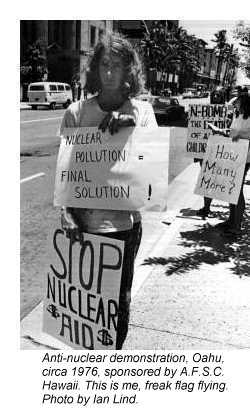 One would be forgiven for expecting the Web to have had a wider and deeper impact on society. Yes, it has
sparked innovations, but these are largely in the commercial and communications areas. OK, so you can have
a hundred myspace.com pals and a lengthy list of phone numbers in your mobile phone, but how many real
friendships have you nurtured with all that communicating? To a skeptic, it seems as if the entire
"revolution" is a meta-game in which worker bees sacrifice communion, creative time and actual
friendships to better serve the gods of increasing productivity.
One would be forgiven for expecting the Web to have had a wider and deeper impact on society. Yes, it has
sparked innovations, but these are largely in the commercial and communications areas. OK, so you can have
a hundred myspace.com pals and a lengthy list of phone numbers in your mobile phone, but how many real
friendships have you nurtured with all that communicating? To a skeptic, it seems as if the entire
"revolution" is a meta-game in which worker bees sacrifice communion, creative time and actual
friendships to better serve the gods of increasing productivity.
From this point of view, the consumerist "state religion" has bamboozled the average American, offering them the illusions of friendship and communal ties with techno-toys and an endless distraction of computer games, online chats and music and video downloads. But in exchange for these dazzling, mind-numbing toys, the consumer/worker must relentlessly increase his or her productivity. Consider how the tools of productivity--Blackberries, cellphones and online "collaborations"--are nearly identical with the toys--cellphone cameras and games, I.M. and collaborative gaming. The meta-game enables corporations to increase their profits annually by a staggering 15% year after year, amassing an unprecedented cash horde of $2 trillion, while the worker bees take their tiny raises (barely keeping up with inflation, if that) and go out to buy another gimcrack electronic "entertainment." Marx warned that religion was the opiate of the masses; perhaps now he would see the real opiate is an ennervating, bland consumerism which actively seeks to turn everyone into 18-hours-a-day, sleep-deprived "consumers" of "entertainment." Is it any wonder the "entertainment" is so empty and tepid? How could it be otherwise? For more photos, both archival and present, by Ian Lind of Ka'a'awa, Hawaii, visit ilind.net November 16, 2005 The Strolling Bones: Rock of Ages Imagine, if you are old enough to do so, a stadium in 1965 filled with adoring fans young and old alike, cheering for a band which had introduced their sound 40 years before. What band started in 1925 could have filled such a stadium in 1965? The answer is: no band which started playing "their music" in 1925 could have filled more than a smoky club filled with senior citizens reliving the music of their youth. Yet today, in the glorious year of 2005, many thousands of fans who were infants or not yet a twinkle in their parents' eyes, flock to see the Rolling Stones, affectionately known to those of us of a certain age as the Strolling Bones, a band which burst on the scene in 1965, fully 40 years ago. Here is a glowing review of their recent gig in SBC Park in San Francisco in the S.F. Chronicle. Could a 62-year old jazz great fill a vast stadium with fans today? Nope--the (now smoke-free) club gig is all he or she could hope for.  Meanwhile, just down the road in San Jose, Sir Paul McCartney, age 62, filled another stadium of fans
paying major bucks to see one of the last living Beatles perform real live Beatles tunes. This is
certainly a unique time in musical history, for the entertainment section of any major newspaper gives
anyone alive in the 70s a serious case of flashback. The bands of your youth--even the "classic" bands
which were already "old"--are still filling the seats: The Moody Blues, Bonnie Raitt, Richard Thompson,
Peter Frampton, James Brown, Smokey Robinson, The Temptations, Tower of Power--this is just a selection
from recent weeks, never mind Mick and the crew or Sir Paul. Then there's Aerosmith, Jimmy Buffett, Gordon Lightfoot,
Tom Jones, The Eagles, Santana, Cream, Hall & Oates, even Dylan, for goodness sakes--the list of acts which launched their music in the 60s or 70s who
are still drawing huge crowds goes on and on.
Meanwhile, just down the road in San Jose, Sir Paul McCartney, age 62, filled another stadium of fans
paying major bucks to see one of the last living Beatles perform real live Beatles tunes. This is
certainly a unique time in musical history, for the entertainment section of any major newspaper gives
anyone alive in the 70s a serious case of flashback. The bands of your youth--even the "classic" bands
which were already "old"--are still filling the seats: The Moody Blues, Bonnie Raitt, Richard Thompson,
Peter Frampton, James Brown, Smokey Robinson, The Temptations, Tower of Power--this is just a selection
from recent weeks, never mind Mick and the crew or Sir Paul. Then there's Aerosmith, Jimmy Buffett, Gordon Lightfoot,
Tom Jones, The Eagles, Santana, Cream, Hall & Oates, even Dylan, for goodness sakes--the list of acts which launched their music in the 60s or 70s who
are still drawing huge crowds goes on and on.
My point is simply this: if music is so great nowadays, why are 35 and 40-year old bands filling stadiums which only a handful of current bands can fill? Lest you think I'm just another hippie Boomer having a gray-haired ponytail moment (alas, I cut that off long before it went gray), please tell me with a straight face that Coldplay or 50 Cent or (insert the name of your fave band of the moment) is going to fill a stadium of fans old and young in 2045--yes, 40 years hence. Yes, there's good music being made today, often very good music--Coldplay, Green Day, Death Cab for Cutie, Taking Back Sunday, Lagwagon, and hundreds of other bands--but the question remains: will anyone 40 years from now pony up a buck to see these bands, especially young fans who aren't just reliving their youth? Let's be kind and simply say that these bands will all be long forgotten in 20 years, never mind 40 years. And why is this so? The conclusion is rather obvious: their music is all derivative. It is neither fresh nor signally creative. There is no "Abbey Road" or "Revolver" or "Exile on Main Street" today. You might argue that U2's "Joshua Tree" will make the cut, and you might possibly be right. But then again, U2 may well be as obscure as XTC in 2028, 40 years after their prime. Will their music stand alongside Hendrix, Marley, Lennon or those others who have already withstood the test of nearly four decades? I doubt it. But don't blame me for pointing out the obvious: your iPod holds 10,000 songs, but most of them are derivative retreads which will be forgotten, and for good reason, in a few short years. Don't take it personally; we can't all grow up in times of musical innovation and greatness. Just enjoy the Rock of Ages classics for what they are: classics. November 15, 2005 Is Our Education System Based on a Factory Metaphor?  The laudable goal of the "No Child Left Behind" standards for U.S. students is to provide a uniform
level of competence in core fields such as English, math and science. But perhaps this entire model
of education is based on the faulty metaphor of education as a factory. I first began thinking about
this some years ago when I realized that the physical plant of large high schools looked for all the world
like a factory.
The laudable goal of the "No Child Left Behind" standards for U.S. students is to provide a uniform
level of competence in core fields such as English, math and science. But perhaps this entire model
of education is based on the faulty metaphor of education as a factory. I first began thinking about
this some years ago when I realized that the physical plant of large high schools looked for all the world
like a factory.
If you doubt this, please examine this facade of a shuttered Ford assembly plant in the Bay Area, and imagine it with milling students and a flagpole flying the American flag. This 1930 factory, designed by noted architect Albert Kahn, is a very handsome building. Isn't the resemblence to a large city high school rather striking? Then I began thinking of the "factory production schedule" which funneled hundreds or thousands of students into set courses within large mechanistic plants each day and each year, regardless of their individual attributes, strengths and weaknesses. Like an assembly line of manufactured articles, some students were "rejects" who couldn't make the "quality control" grade, and they were thrown on the scrap pile or dropped out when the scrap pile loomed as their certain future. Now, with globalization bringing unprecedented competition to our workforce, the nation is demanding better education to save our workers from marginalization. The O.E.C.D. recently issued a report on education in the U.S. entitled "Competing in the Knowledge Economy." To quote from the paper: The quality of the learning of 15-year-olds in the United States, particularly in mathematics and problem solving, are well below those of many European countries and also Japan, Korea, Australia and New Zealand. With its relatively high expenditure and its relatively low student achievements at the school level, the United States education system is clearly inefficient.The report also stated that the economic advantage of education, as measured by productivity gains, is not as clear as the wage differences between those with high school educations and those with college degrees. In other words, the overall vitality of an economy is influenced by many more factors than education. Which leads me to question: what if a kid is as dumb as a brick in math but a near-wizard in graphic arts? Do we scrap him because he didn't meet some factory-defined narrow standards for "knowledge worker"? What about all the jobs which aren't in biotech and technology? What if we required basic understanding of making meals with real food rather than the processed contents of a box? What if we required kids to know how to fill out a Schedule C form (small business) for a tax return, or change the oil in their car, or install shelving, or fill out a loan application and understand credit, adjustable rate mortgages and deductables in insurance policies? Aren't these skills more productive for the vast majority of workers than advanced math? Perhaps the factory metaphor is precisely the wrong one in a rapidly evolving global economy. Maybe instead of cramming all kids into narrow channels of "competence," we should actively filter out kids whose skills, interests and strengths lie elsewhere than math and science: the culinary arts, graphic arts, marketing, etc., all skills which cannot be shipped overseas as readily as those lauded "knowledge worker" skills of programming and gene sequencing. Perhaps we should take as a new metaphor the mixed-use, adaptable uses which will soon be occupying this old Ford factory. Some people will live next to their workshops, some will make beer, some will toil in front of computer screens; the final product mix will adapt and evolve along with its tenants. If a child finds math easy and interesting, then by all means let's encourage him or her to reach the highest levels of math and science. But if a child's strengths and talents lie elsewhere, then let's turn the factory into a workshop where he or she can thrive and acquire skills which are just as valuable to our society as a whole as advanced math and science. It's worth recalling that Steve Jobs' brief college career included an utterly impractical interest in calligraphy. That utterly impractical interest, as we know, led directly to the Macintosh computer's built-in fonts and the desktop publishing revolution which Jobs' Apple Computer single-handly launched in the late 1980s. Can you calculate the value of what would have been lost if Jobs hadn't been free to follow his interests? My own guess is hundreds of billions of dollars in software, hardware and improved productivity. November 14, 2005 Exporting the Real Estate Bubble to China 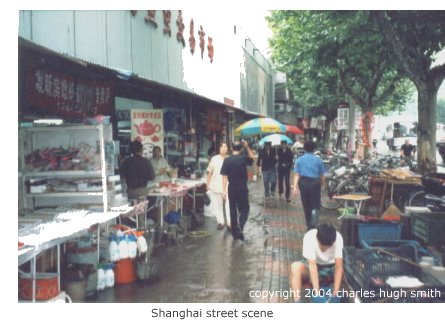 Everyone is agog at the immense trade deficit the U.S. has with China, but fear not, we are exporting
something equally enormous back to China:
our very own real estate
bubble. As this link explains, low U.S. interest rates and the huge trade imbalance has flooded Asia
with dollars. The Chinese have added gasoline to this already roaring fire by relentlessly boosting their
own money supply; according to the Wall Street Journal,
China increased its money supply by 18% while their economy grew at a more modest 8%.
Everyone is agog at the immense trade deficit the U.S. has with China, but fear not, we are exporting
something equally enormous back to China:
our very own real estate
bubble. As this link explains, low U.S. interest rates and the huge trade imbalance has flooded Asia
with dollars. The Chinese have added gasoline to this already roaring fire by relentlessly boosting their
own money supply; according to the Wall Street Journal,
China increased its money supply by 18% while their economy grew at a more modest 8%.
Similar imbalances between inflation-feeding rapid growth of money supply (M2 or M3 as the economists call it) and much lower growth of actual economies is a worldwide phenomenon. Such vast increases in money supply typically cause inflation. Yet the inflation rate remains low everywhere. So where's all that money flowing, if not into goods and services? It's flowing into assets. What we are witnessing is an unprecedented global inflation of fixed assets, i.e. real estate. Here are some other links describing the Chinese real estate bubble: The Political Economy of Shanghai’s Real Estate Bubble by Wenhui Zhu Wangjianshuo's blog on Shanghai real estate China takes step to deflate an impending property bubble (Int'l Herald Tribune) November 12, 2005 Corruption and Avian Flu: China's Dynamic Duo of Destruction  If you follow events in China closely, you already know that corruption reaches from the roots to the
treetops in every sector of the government and economy. Now, those same sectors are tasked with controlling
the H5N1 avian flu virus.Unsurprisingly, counterfeit bird flu vaccines are being distributed, along with
all the other useless counterfeit medications which flood the nation.
As reported in the
S.F. Chronicle and other newspapers,
If you follow events in China closely, you already know that corruption reaches from the roots to the
treetops in every sector of the government and economy. Now, those same sectors are tasked with controlling
the H5N1 avian flu virus.Unsurprisingly, counterfeit bird flu vaccines are being distributed, along with
all the other useless counterfeit medications which flood the nation.
As reported in the
S.F. Chronicle and other newspapers,
"In Liaoning, the government warned earlier that counterfeit vaccines were being sold, raising the possibility that millions of chickens, ducks and other birds weren't properly inoculated. China suffers from rampant counterfeiting of food and medicines."The problem of bird flu spreading in China is not chicken feed, to use a poor pun; the last two global flu pandemics began in China, back in the 60s when there were far fewer chickens in China and far fewer transportation links. The opportunities for avian flu to jump to humans is by all accounts greater now than then, and the vast increase in trade and travel within China more or less guarantees a rapid dispersion of any flu outbreak. Chinese authorities are doing their best to control outbreaks; to quote the story linked above, "The first case in Jinzhou on Oct. 26 prompted officials to destroy more than 6 million birds." That's a lot of chickens. But the real story here is that the chickens of pervasive corruption are coming home to roost. We all know what happens when watered-down vaccines or germicides are administered to humans and other animals; the infectious agents (virus, bacteria or parasites) quickly become resistant, and even strong doses of the medication are no longer effective. To put it plainly: the standard Chinese practise of distributing counterfeit drugs (packaged as legitimate medications) will enable the stealthy spread of the virus and cultivate super-viruses which are resistant to existing vaccines. This is a non-trivial part of the avian-flu story, and it may well be the mechanism which actively enables the virus to make the genetic jump to humans. (For more on the systemic nature of corruption in China, see my report China: An Interim Report.) Given the obvious dangers, you might think that the government would step up its efforts to control corruption; instead, it seems to have stepped up its suppression of whistle-blowers; here is a China-based blog on the same case of Huang Jingao, who wrote a celebrated open letter describing the deep corruption of local officials who were grabbing farmers' land to sell to developers. Now Jingao has been imprisoned for life under trumped-up charges of accepting bribes (a universal perk of Chinese officialdom) and having mistresses (another perk of Chinese officialdom). The irony must not be lost on his persecutors; lock away the whistle-blower by accusing him of the ubiquitous, run-of-the-mill corruption which is par for the course in China. Put these two stories together, and you have a society too corrupt to effectively control avian flu. It is impossible not to conclude that a serious outbreak of H5N1 avian flu in China is inevitable. November 11, 2005--Veteran's Day "This whole damn thing is about oil, isn't it?"  Today we honor all those who either volunteered or were called to serve the nation in the armed forces.
It is right and fitting that we not only honor each individual, but take a hard look at the causes they
were called upon to fight for.
Today we honor all those who either volunteered or were called to serve the nation in the armed forces.
It is right and fitting that we not only honor each individual, but take a hard look at the causes they
were called upon to fight for.
In this light, I call your attention to a prescient film from 1975, Three Days of the Condor The film seems especially prescient now, given that the fictional network's goal was planning a U.S. invasion of the Mideast. Voila, 30 years later, the U.S. has invaded the Mideast. When the Redford character finally confronts the rogue C.I.A. leader of the plan, he connects the dots and says, "This whole damn thing is about oil, isn't it?" Exactly. Let's be clear about why the U.S. Armed Forces are in Iraq, rather than, say, Ecuador or Nepal: it's the strategic importance of the region's oil. Yes, the plan is to transform Iraq into a democratic nation, which will lead the entire region in that direction. But the U.S. isn't committing its treasure and citizenry to all troubled regions of the globe equally; we are in Iraq because it is the strategic linchpin of the region. Without access to the Mideast oil reserves, the world economy would be shaken to its foundations. There are many troubled, undemocratic regions in the world--for example, much of Africa; yet we fight now to establish democracy in only one troubled region, the Mideast. Coincidence? No. Simple self-interest. As the Cliff Robertson character says at the film's conclusion: "When the people are cold and their engines stop running, they're not going to ask us why; they'll just want us to go get it." Realizing that he is an embarrassment to the C.I.A. (the inevitable role of any whistleblower, even a reluctant one), at the film's end Redford gives the entire story to the New York Times. The Robertson character, a C.I.A. station chief who was caught off-guard by the hidden conspiracy, says, "But will they print it?" Redford is taken aback at the implication--that the government could pressure the media to suppress the story--and then he avers, less confidently, "They'll print it." This is the core of democracy: that a free press keeps a government answerable to its people. Without a free and skeptical press, all the elections in the world mean nothing. November 10, 2005 Selling the Landscape: Sold--5% of State of Maine As noted here on Nov. 5, the world is awash in $46 trillion in cash, all of it seeking high returns. Now for sale: the U.S. landscape; owner: your typical shady hedge fund, or worse. If you're a subscriber to the Wall Street Journal, check out this story online: U.S. Timberland Gets Pricey As Big Money Seeks Shelter. (Non-subscribers can read it at their local library.) The story's headline encapsulates the issues very neatly: "Rush Reflects Glut of Capital, Low Payoff on Other Assets; Sold: 5% of State of Maine But Do Trees Grow to the Sky?" Here's the situation in a nutshell: as it gets harder and harder to make a killing in real estate and global stock markets, and as low interest rates guarantee most bonds don't even keep pace with inflation, then money managers are pouring money into "hard assets" like timberland. There's only three problems with this land rush: And why will the bubbles all pop? Inflation is rising globally, will will necessarily push interest rates higher. As the cost of servicing the enormous mountain of accumulated debt rises, so will bankruptcies; once cheap money disappears, then there will be no buyers left to bid up overpriced assets. Once buyers vanish, then prices plummet. As prices drop, owners must liquidate assets at a faster clip to make their interest payments, creating a vortex of increasing "fire-sales" and sinking assets values. As more owners fail to make interest payments, banks repossess more assets and auction them off, increasing the oversupply of assets for sale, adding even more downward pressure on the price. A self-feeding cycle of wealth destruction will be firmly in place, with no end in sight. But don't take my word for it--just keep your eyes open in late 2006, when the cycle will become clearly visible. November 9, 2005 What Me Worry? It's only Oil Consider this recently issued statement from the Gulf, detailing the continuing shutdown of oil and gas production: Today's shut-in oil production is 773,097 BOPD. This shut-in oil production is equivalent to 51.54% of the daily oil production in the GOM (Gulf of Mexico), which is currently approximately 1.5 million BOPD. Today's shut-in gas production is 4.482 BCFPD. This shut-in gas production is equivalent to 44.82% of the daily gas production in the GOM, which is currently approximately 10 BCFPD. The cumulative shut-in oil production for the period 8/26/05-11/07/05 is 80,526,022 bbls, which is equivalent to 14.708% of the yearly production of oil in the GOM (approximately 547.5 million barrels). The cumulative shut-in gas production 8/26/05-11/07/05 is 414.298 BCF, which is equivalent to 11.351% of the yearly production of gas in the GOM (approximately 3.65 TCF).Or this: James Howard Kunstler, in his Commentary on the Flux of Events, writes, "Since the hurricanes shredded our Gulf of Mexico oil and gas capacity, Europe has been sending us 2 million barrels of crude oil and 'refined product' a day from its collective strategic petroleum reserve. Now, the important part of all this is that last week the International Energy Agency (IEA), Europe's energy security watchdog, declared that it would now end the 2 million barrel a day shipments to the U.S."So half of the oil production of the entire Gulf area is still off-line, and 45% of the natural gas production is similarly shut down. We've already lost 15% of the region's entire annual production, and yet nobody's worried about some eventual consequence, such as future shortages? Can the Gulf lose half its petroleum production for months on end, and there be no consequences? That would seem foolhardy, but there's no word in the media except gasoline prices are dropping. Wonderful--but for how long? November 8, 2005 Beauty of the Augmented Kind  The popularity of Korean melodramas throughout Asia and the U.S. is an old story. But the surge in
popularity has triggered an ugly side-effect: rampant plastic surgery in Asia. While I certainly don't know
if actress Lee Young-Ae (photo on right) has been enhanced by the knife, apparently many if not most Korean actresses have undergone
multiple cosmetic surgeries. And it's not just actresses; blessed as we are with many Korean friends, we
have been told that a high percentage of young Korean women have undergone multiple cosmetic
procedures.
The popularity of Korean melodramas throughout Asia and the U.S. is an old story. But the surge in
popularity has triggered an ugly side-effect: rampant plastic surgery in Asia. While I certainly don't know
if actress Lee Young-Ae (photo on right) has been enhanced by the knife, apparently many if not most Korean actresses have undergone
multiple cosmetic surgeries. And it's not just actresses; blessed as we are with many Korean friends, we
have been told that a high percentage of young Korean women have undergone multiple cosmetic
procedures.
Before we get to "why?", let's first consider the popularity of Korean soap operas. One of my good friends in Hawaii has confessed to a mild "jones" for the dramas (if you own the DVDs, you might as well fess up), and his views on their popularity are cogent: It's pretty ridiculous if you step back and look at the whole deal. Most of the stories are variations on one theme and it's usually a love triangle, with some terminal illness thrown in. A lot of the appeal is definitely in the "damn good-looking guys and gals" as you say, and I think it takes all the middle age folks who make up the bulk of the fanatics back to their own days of young love and heartache. Our 20-something year old niece thinks they're stupid. There are lots of them available on DVD and we've been buying ours through eBay. Certain actors are really popular just as in the West. Some have terrible subtitling, often funny, while others are fine. Some stories have a humorous slant, but most are sad to the point of depressing, ha! I told myself I'd had it because it's not good to get so sad watching 'entertainment', but we're still 'going to Korea' every other night or so, nuts! It's the typical thing of having to see what happens next. And I guess it's popular also because it is Asian and for us as Asians, there's a lot we can relate to in a cultural sense, like things left unspoken, and self-denial, sacrifice, etc.For a primer on the whole phenomenon, check out this fan website based in Hawaii. A site based in Los Angeles has a well-thought out essay on the topic. As we all know, plastic surgery doesn't always result in peaches and cream; here is a report reprinted from the Wall Street Journal wire service on the rise of Korean-inspired plastic surgery in Asia. For a Chinese perspective on the explosion of cosmetic surgery in China, check out this Xinhua report on plastic surgery in China linked to the popularity of Korean dramas. And lastly, here is a disturbing story in Time-Asia on plastic surgery disasters in Asia. Now let's get back to this perceived need to augment perfectly attractive Asian faces. The standard story is that Korean dramas are feeding Asian pride in Asian beauty; if that were true. I would stand and applaud most heartily. As a member via marriage of Asian-American families for the past 35 years, I reckon the average Asian person is as good as or better looking than the average Round-eye/haole/Caucasian, etc. So if Korean beauties are already beautiful, which is clearly the case, why are they having multiple cosmetic surgeries to look more Round-eye? For if you read the above links, you find the uncomfortable truth is that the surgeries are not to enhance their Asian features but to soften or eliminate them. Doesn't anyone else find that disturbing? Judging by what I read on the Web, it's not politically correct to comment on this topic. What's also disturbing is that the new wave of cosmetic cutting isn't just attracting the usual crowd of 45-year olds trying to turn back the clock a la Hollywood, but 20-somethings in the prime of their youthful beauty. I would like to see Asian standards of beauty held on high, but without thousands of dollars of risky plastic surgery being done to remodel perfectly beautiful young faces. Apparently this leaves me in the decided minority. The reasons for this insecurity are beyond the reach of this single entry, but I cannot conclude that the influence of Korean dramas is positive for Asia, at least in regards to encouraging standards of "beauty" which require cosmetic surgery to attain. November 7, 2005 The Downside of Density  It is an axiom of sound environmental policy that higher housing densities are better than low density
sprawling subdivisions. The reasoning is obvious to anyone stuck in endless traffic heading for the
exurbs: shorter commutes, which improve family life and air quality, conservation of cropland, which
would otherwise be paved over with thousands more faux stucco mansions, and a healthier lifestyle centered
around a dense community accessible to pedestrians and bicyclists. Granted--but not all density is equal. This topic arose in long weekend conversations
with my brother-in-law, who is a professor of art at a major university (my alma mater, as it happens). He
pointed out that lofty apartment living is very high density, but residents have no place to garden or work
with tools--two activities which are not only important to both of us as individuals, but are defining
characteristics of the human species.
It is an axiom of sound environmental policy that higher housing densities are better than low density
sprawling subdivisions. The reasoning is obvious to anyone stuck in endless traffic heading for the
exurbs: shorter commutes, which improve family life and air quality, conservation of cropland, which
would otherwise be paved over with thousands more faux stucco mansions, and a healthier lifestyle centered
around a dense community accessible to pedestrians and bicyclists. Granted--but not all density is equal. This topic arose in long weekend conversations
with my brother-in-law, who is a professor of art at a major university (my alma mater, as it happens). He
pointed out that lofty apartment living is very high density, but residents have no place to garden or work
with tools--two activities which are not only important to both of us as individuals, but are defining
characteristics of the human species.
In theory, communal gardens and work spaces are possible; while living in a tiny studio in the super-dense Makiki area of Honolulu in the mid-70s, we signed up for a small garden plot in the then-new City communal gardens. Each participant received a plot about 10 feet by 16 feet for their private use. An amazing quantity of vegetables can be grown on even this modest plot of earth.  Similar community workspaces are available in various locales--for instance,
The Tinker's Workshop in Berkeley--but over
time, it seems that most people prefer their own private workbench or garage.
Similar community workspaces are available in various locales--for instance,
The Tinker's Workshop in Berkeley--but over
time, it seems that most people prefer their own private workbench or garage.
Density as measured by number of residents per square mile can describe wildly different urban environments. It is instructive to compare global cities by their density; this chart lists the population densities of a few well-known cities around the world. Scroll down this page and glance at the photo of a typical Parisian street, and you'll see why Paris is twice as dense as New York City. You may be surprised that a city (not the suburbs, but Paris proper) which is "only" six or seven stories in height is so much denser than high-rise-rich NYC. Certainly, Parisian apartments are modest in size, and that is a key metric in density. But is turns out uniformly low-rise buildings are denser than high-rises surrounded by parking lots, open spaces or commercial (non-dwelling) areas. Thus, San Francisco achieves a significantly higher density than London, even though most of the city is two and three-story dwellings as pictured above. (Not all are so gaily painted.) As the accompanying photos of Parisian parks reveals, the high density of Paris is offset with vast tracks of parkland and urban gardens--for instance, Jardins du Luxumbourg. But the trade-off mentioned at the beginning of this entry is definitely in force: there is no space in most Parisian apartments to work on a bicycle or build a cabinet, and no space for a garden, unless you count a flower box as tillable soil. The San Francisco Victorian pictured above, on the other hand, has a small one-car garage (not always, but often) and a small backyard--perhaps too shaded by surrounding houses to flourish as a garden, but a patch of soil nonetheless. While great parks (San Francisco has its Golden Gate Park) ease the stresses inherent in beehive densities, they are public, not private spaces, and you can't grow your own flowers and vegetables in them. Is this an argument for exurbian homes of 4,000 square feet and three-car garages? Obviously not. Such exurbian subdivisions may have more vehicles than people (perhaps ten residents per acre or less), and while the residents have the space to work on a bicycle, they have neither the time to perform the work (most of their non-working life is spent commuting) and no place to ride the bike even if it is in working order--all the roadways are designed for cars and trucks, not bikes. But environmentally sound urban planning does need to recognize that private work spaces and gardens are integral to human life. Such private worlds, however small, should not be sacrificed to the gods of density without compensating mechanisms--or at a minimum, recognition of what is being lost in a high-rise lifestyle devoid of dirt, grease and sawdust. November 5, 2005 Clear Skies or Storm Clouds Gathering? Global stock markets are rising in euphoric unison from recent jitters, as everyone from media pundits to Alan Greenspan reports that the global financial picture is solidly secure beneath a clear sky. Oh really? Then what are we to make of these storm-cloud stories? First up is that pesky avian flu which continues spreading around the globe. Yahoo ran a story yesterday entitled Flu pandemic risks sparking global recession. Today's news is Avian Flu Outbreak in China, Vietnam and China. Some commentators note that the risk of this avian flu jumping over to humans may be overstated. But even if we grant that, the danger to the world economy is the fear of such a pandemic will be enough to trigger travel and trade restrictions. I commented on this danger in a July 3 entry Will Avian Flu Trigger a Global Depression? Next up is the high cost of energy/fossil fuels. The stock market has been racing up in reaction to oil dropping briefly under $60 a barrel. But alas, the price just jumped back to $62/barrel. Could it have something to do with the fact that the Gulf oil patch is still crippled? Consider this from yesterday, November 3: "Analysts remain concerned that U.S. output of oil and natural gas remains constrained by hurricane-related damage to platforms and pipelines. The U.S. Minerals Management Service said Thursday that 52 percent of daily oil production and 47 percent of natural gas production in the Gulf of Mexico remained off-line, slightly lower than Wednesday."Then there's the global increase in cash sloshing around, looking for returns in risky places. The Wall Sreet Journal of November 3, 2005 headlined a story "Stash Flow: Huge Flood of Capital to Invest Spurs World-Wide Risk Taking Corporate and Foreign Savings Chase Assets, Driving Prices Up, Keeping Returns Low" "It's a sign of a major global investment phenomenon: There's an unprecedented wave of capital flowing around the world, with all of its owners anxiously searching for a better return. World pension, insurance and mutual funds have $46 trillion at their disposal, up almost a third from 2000. In the same period global central-bank reserves have doubled to $4 trillion, and other gauges of available capital have risen as well."$50 trillion in cash is a lot of do-ray-mi. Even the mighty U.S. Federal Debt of $8 trillion starts looking puny. But as Sherlock Holmes might have commented, "What about the dog which didn't bark?" The dog that didn't bark in this account is: where did the $11 trillion in extra cash since 2000 come from? Let's think about this for a long skeptical moment. In 2000, the entire World pension, insurance and mutual fund industries held $35 trillion, which was basically all the accumulated capital (not including real estate and other fixed assets) of the entire non-communist world. How long did it take to accumulates this $35 trillion? A long time--decades, if not hundreds of years of saving and investment. Then, as if by magic, this global pool of capital suddenly increases by a staggering $11 trillion in only five years. Doesn't this strike you as slightly too good to be good? Recall, after all, that the years 2000-2005 witnessed a massive decline in stock valuations in the Dot-Bomb debacle; the Nasdaq stock market is still at only 40% of its 2000 top. By all rights, global capital should be lower five years after that destruction of wealth. (Other stock markets have also done poorly in the same period.) Instead, it's leaped by a mind-boggling $11 trillion--about the size of the entire U.S. GDP. So where did all this money come from, if not from stock market gains? Global savers account for at most about $1 trillion annually; recently, the U.S. has been sucking up about 80% of that total global savings. Governments around the world have been running huge deficits these past five years as well, so where they got the dough to double their reserves is a mystery as well. $1 trillion a year in savings for five years would add up to an extra $5 trillion. Then where did the extra $6 trillion come from, if not from savings? Could this come from borrowing fueled by various real estate bubbles, or other types of borrowing? There doesn't seem to be any other source. So what we really have is a vast horde of borrowed, leveraged money seeking higher returns by absorbing larger and larger risks. If this isn't the perfect set-up for a global meltdown, I would like to see a superior one. November 4, 2005 Disengaging From Iraq If you've already made up your mind in favor of immediate and total withdrawal from Iraq, read no further. But if you still have a glimmer of an open mind about the situation in Iraq, then I recommend reading the lead article in the latest Foreign Affairs magazine. Penned by President Nixon's Secretary of Defense Melvin Laird, Iraq: Learning the Lessons of Vietnam, the piece is an unflinching defense of a strategy of gradual withdrawal from Iraq based loosely on the lessons of Nixon's "Vietnamization" of the Vietnam War. Laird is no chicken hawk; he was wounded in combat in the Pacific Theatre of World War Two, and arrived on the scene in 1969 to fulfill Nixon's 1968 campaign promise to end the War. Even if you disagree vociferously with the war or Bush's entry into war, this essay is a thoughtful analysis of how to extricate our armed forces without abandoning those Iraqis who are not insurgents. The magazine (link above) has also drawn a number of essays from its 1969-1975 archives about extricating the U.S. from Vietnam. All the essays are accessible online without subscription. For another perspective on Iraq-Vietnam comparisons, please check out my essay This Is Not A Map of Vietnam. November 3, 2005 Is Japan's Recovery Sustainable? I received a query from an experienced financial analyst in Tokyo, Taro Akasaka, who writes a very well-informed blog on real estate issues and news in Japan. Mr. Akasaka was kind enough to ask my opinion of a key economic question: "One of my concerns these days, as a financial analyst in Tokyo, is how the coming US economic slowdown might affect the Japanese economy. Will it be the undoing of Japan's recovery, or will we shake off America's doldrums and continue our spell of growth?" In other words, is Japan's recovery sustainable, even if America slides into recession? The question cannot be answered, in my opinion, without considering these macro-economic issues: In general, I am not an optimist on the global economy 2006-2012. Therefore I am very skeptical of analysts who foresee a healthy Japanese economy while the rest of the world is in a global depression. The Japanese economy remains dependent on exports for growth, and if the market nations, especially the U.S. and China, fall into a deep, prolonged recession, then how can Japan prosper? The same can be said of the E.U., which is also entirely dependent on exports for its growth. From this perspective, every economy in the world is seeking to follow the Japanese model of high growth through exports. Unfortunately, that leaves only one consumer nation, the U.S., which will soon collapse under the imbalances of its trade deficits, governmental deficits and real estate bubble. Once the U.S. crumbles, the dollar will also decline precipitously, causing the other global currencies to rise. Once the U.S. economy and dollar fall, then China will quickly follow, as it is very dependent on exports to the U.S. and to other countries which also depend on the U.S. market. Furthermore, there are huge imbalances in China's economy which I have discussed in other articles. When the U.S. stops being able to borrow money in order to buy $1.6 trillion annually of other nations' goods, then only nations which do not depend on exports can prosper. Are there any such nations? In other words, it seems to me that the world economy is like a line of dominos. Once the U.S. topples, it will inevitably knock down all the other nations which trade with it and lend it money. The other major economies--Japan, the EU. and China, all depend on exports for growth. Their domestic demand has been too weak to drive growth for over a decade. People in these regions save enormous amounts of money which they are afraid to spend. Why? Do they feel hopeful and optimistic about the future? If so, why do they save rather than spend? This is true in both Europe and in Asia. Do these nations invest in their own assets and productivity? Somewhat, but then why are they lending 80% of their savings to the U.S. via purchases of U.S. Treasuries and corporate bonds? This is not a vote of confidence in their own economies, and not healthy for the U.S. either, where this huge capital inflow has created a housing bubble which will destroy wealth just like the real estate bubble did in Japan. The other factor which is not being appreciated is the enormous creation of liquidity by the world's central banks. Huge sums of money have been created by the Federal Reserve, and to keep their own currency suppressed against the dollar, other central banks have lowered interest rates and created excess liquidity in their own economies. The world is truly afloat on borrowed money. Once liquidity dries up, and interest rates continue rising in the U.S., then there won't be so much money to invest in real estate--in Japan or the U.S. I am sure you know that commercial real estate in the U.S. is also in a big bubble. Buildings which once rented for $50 per square foot in 2000 are being sold for more money than during the Dot-Com Boom, but they only rent for $31/square foot now. Where is the positive cash flow? How can rents go up when millions of new square footage are being built? The oversupply of commercial and residential real estate in the U.S. will be truly huge by next year. In my view, the rise of real estate values in Japan is entirely the result of large capital inflows from the U.S. With too much money laying around in the U.S. (as a result of excess liquidity and trillions in low-interest money borrowed from foreigners via Treasuries and corporate bonds), firms are looking to invest in bargains, and so large amounts of capital are flowing into Japan. At the same time, Japanese investment money is flowing out to build factories in China and the rest of Asia. The Japanese multinationals realise they must invest in low-cost plants outside Japan while maintaining the high-value manufacturing in Japan. While this will enable them to prosper globally, it doesn't necessarily make real estate in Japan a high-return investment. According to the Wall Street Journal of November 2, 2005, Japanese capital is flowing into the U.S.: During the first eight months of this year, Japanese investors poured a net 14.5 trillion yen, or $126 billion, into foreign stocks and bonds, up 19% from the same period the previous year. If the current pace continues, such investments for 2005 will be the highest since 1989, when the government started compiling the current data, surpassing last year's $174 billion. To buy dollar-based assets, investors first have to sell their yen to buy the U.S. currency, which makes the yen weaker against the dollar.You might have noticed my entry on the Kondratieff Cycle, which suggests a global depression will gather steam 2006-2012. All the pieces are in place for just such a depression: unsustainable imbalances in trade, in liquidity, in real estate valuations, in government debt, in private debt and in currency valuations. In my opinion, Japan is blessed with a leader of political genius. Koizumi has enabled Japan to improve its macro situation greatly. But even with these improvements, I don't believe it is possible for the generation behind the Baby Boom to generate growth in Japan from domestic consumption alone. Demographically, there just aren't enough people to spark domestic growth. As everyone knows, Japan's population will soon start declining, and a huge number of people will begin retiring, putting a major financial strain on the government and on their private pensions and savings--and on their children. Furthermore, if interest rates ever rise in Japan in response to improved conditions, then the government will have to pay much higher interest rates on its vast amount of public debt. While that will help the bondholders, it will cause a fiscal crisis for the central government, which already spends huge sums paying interest on the public debt. The same crisis will also strike the U.S. government as it must pay higher interest on $8 trillion. I would like to believe that Japan will avoid the effects of a collapse in U.S. real estate, the dollar and trade, but I don't see how any major nation can avoid the negative effects of such a decline. November 2, 2005 Five Good Things About the Coming Recession As readers of this blog know, it seems obvious to me that the U.S. economy will slide into a deep recession in 2006. The excesses and imbalances of debt, credit, government deficits, rising inflation, trade deficits, foreign ownership of U.S. bonds and rising energy costs are simply too large to be massaged away much longer. But rather than view this "slowdown" (a nice way of saying you're laid off and I'm not--yet) as a negative, I've assembled a quick list of some positives that may well be the silver lining on a deep recession: November 1, 2005 Building Heights and Arboral Roots 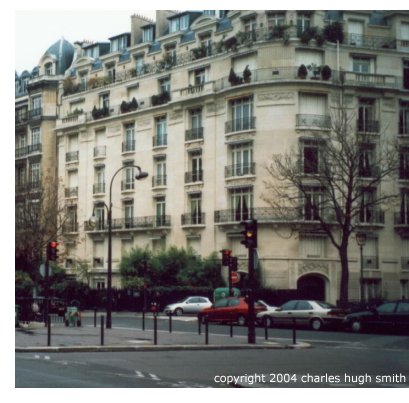 Take a look at this typical Paris street and note the height of the buildings. Paris is largely made
up of buildings six or seven stories in height, and somehow this particular scale is satisfying to the
pedestrian--not so high as to be overwhelming and shadowing, not so low as to seem suburban. There are a
number of practical reasons for this rather uniform height--political restrictions, the engineering limitations
of the building materials used in the 16th and 17th centuries, when much of the city was constructed, and
the inconveniences of ascending higher buildings in the pre-elevator era.
Take a look at this typical Paris street and note the height of the buildings. Paris is largely made
up of buildings six or seven stories in height, and somehow this particular scale is satisfying to the
pedestrian--not so high as to be overwhelming and shadowing, not so low as to seem suburban. There are a
number of practical reasons for this rather uniform height--political restrictions, the engineering limitations
of the building materials used in the 16th and 17th centuries, when much of the city was constructed, and
the inconveniences of ascending higher buildings in the pre-elevator era.
But is it just coincidence that the height of these buildings roughly equals those of canopied or conifer forests? Perhaps our comfort with these stately avenues stems partly from their resemblance to pathways cleared in the canopied tropical and temperate conifer forests of our distant past. Noting a small milestone: In reviewing the server logs of this website, I note that 2,396 unique visitors stumbled across the site in October, viewing a record 10,019 pages. In the great sprawl of the Web, these are very modest figures; but as always, I greatly appreciate your readership and hope to continue writing bits and pieces worthy of your visits. wessay noun, combination of 'web' and 'essay,' denoting a short essay which exploits the hyperlinks, interfaces and interactive capabilities of the World Wide Web; coined by Charles Hugh Smith on May 1, 2005, in Berkeley California. copyright © 2005 Charles Hugh Smith. All rights reserved in all media. |
Subscribe via RSS: ![Validate my RSS feed [Valid RSS]](valid-rss.png)
![Validate my Atom 1.0 feed [Valid Atom 1.0]](valid-atom.png) search my site:
search my site:
|
||
|
|
home |